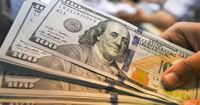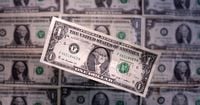The U.S. dollar has been experiencing a significant decline against major currencies recently, raising concerns among investors. On Friday, April 11, 2025, the dollar fell sharply, hitting a decade low against the Swiss franc and a three-year low against the euro. This depreciation is attributed to various factors, including chaotic tariff policies implemented by U.S. President Donald Trump, which have shaken confidence in the dollar's status as a safe haven asset.
China's decision to raise import taxes on U.S. goods from 84% to 125% in retaliation to Trump's increased tariffs of up to 145% on Chinese products has further exacerbated the situation. This tit-for-tat trade war has led to a significant sell-off in global markets, impacting not only the dollar but also U.S. Treasury bonds, which are traditionally viewed as safe investments.
Brad Bechtel, the global head of foreign exchange at Jefferies, noted that the current situation marks a notable shift in investor behavior. “There’s a significant migration happening as foreign investors diversify away from the U.S.,” he stated. “Those still engaged in the U.S. market realize they need to hedge against currency risk, which is increasing pressure on the dollar.” As a result, the dollar index, which measures the greenback's strength against a basket of currencies, fell by 0.56% to 99.78, the lowest level since April 2022.
Furthermore, consumer sentiment in the U.S. has deteriorated sharply in April, with inflation expectations for the next 12 months soaring to their highest since 1981. This decline in consumer confidence has contributed to the perception that the U.S. economy may be heading towards a recession.
On the foreign exchange market, the dollar depreciated by 0.9% to 0.81650 against the Swiss franc, marking its lowest point since January 2015. It also fell 0.51% to 144.05 yen, approaching its lowest level since September 2024. The dollar's weakness has led to a surge in gold prices, which exceeded $3,200 per ounce, as investors seek refuge in precious metals.
Christine Lagarde, President of the European Central Bank (ECB), announced that the ECB is prepared to deploy measures to maintain financial stability. This has contributed to the euro's rise, which increased by 1.25% to $1.134050, reaching its highest point since February 2022. The British pound also gained ground, rising 0.89% against the dollar to $1.30825.
Richard Yetsenga, Chief Economist at ANZ, commented on the broader implications of Trump's unpredictable trade policies, stating, “Regardless of how the next 90 days of negotiations unfold, America's international credibility has been damaged.” The chaotic nature of recent tariff decisions, including the imposition and subsequent postponement of taxes on over 60 trading partners, has created uncertainty in global markets.
As a result, the dollar is gradually losing its status as a safe haven, making creditors more cautious about lending to the U.S. In fact, the U.S. is now paying higher interest rates than countries like Italy, Spain, or Greece to raise capital. This shift in investor sentiment could have long-lasting effects on the U.S. economy, especially considering the trillions of dollars that have flowed into the U.S. market over the past decades.
Market analysts have expressed mixed opinions on the future of the dollar. Some believe that the current sell-off may be temporary, while others warn that the weakening of the dollar could lead to increased interest rates, putting additional pressure on both bonds and stocks. Christopher Wood, Global Head of Equity Strategy at Jefferies, remarked, “The Trump administration seems to be ignoring the heavy reliance of the U.S. on foreign capital, as reflected in the country’s net international investment position.”
In summary, the U.S. dollar's recent decline underscores the growing challenges facing the American economy amid escalating trade tensions and shifting investor confidence. As the situation unfolds, the implications for both domestic and global markets remain uncertain, prompting investors to closely monitor developments in U.S. economic policy and international relations.





